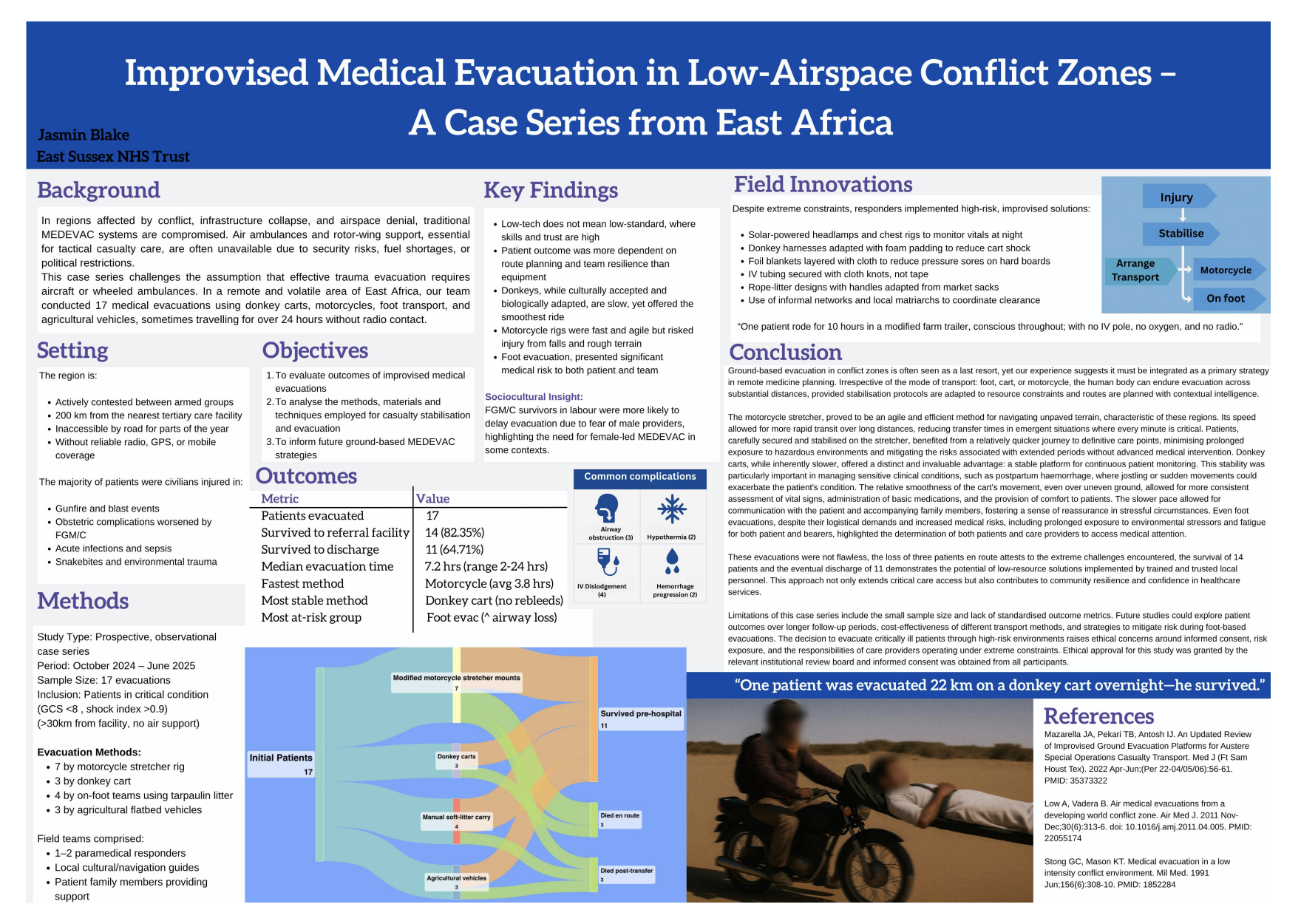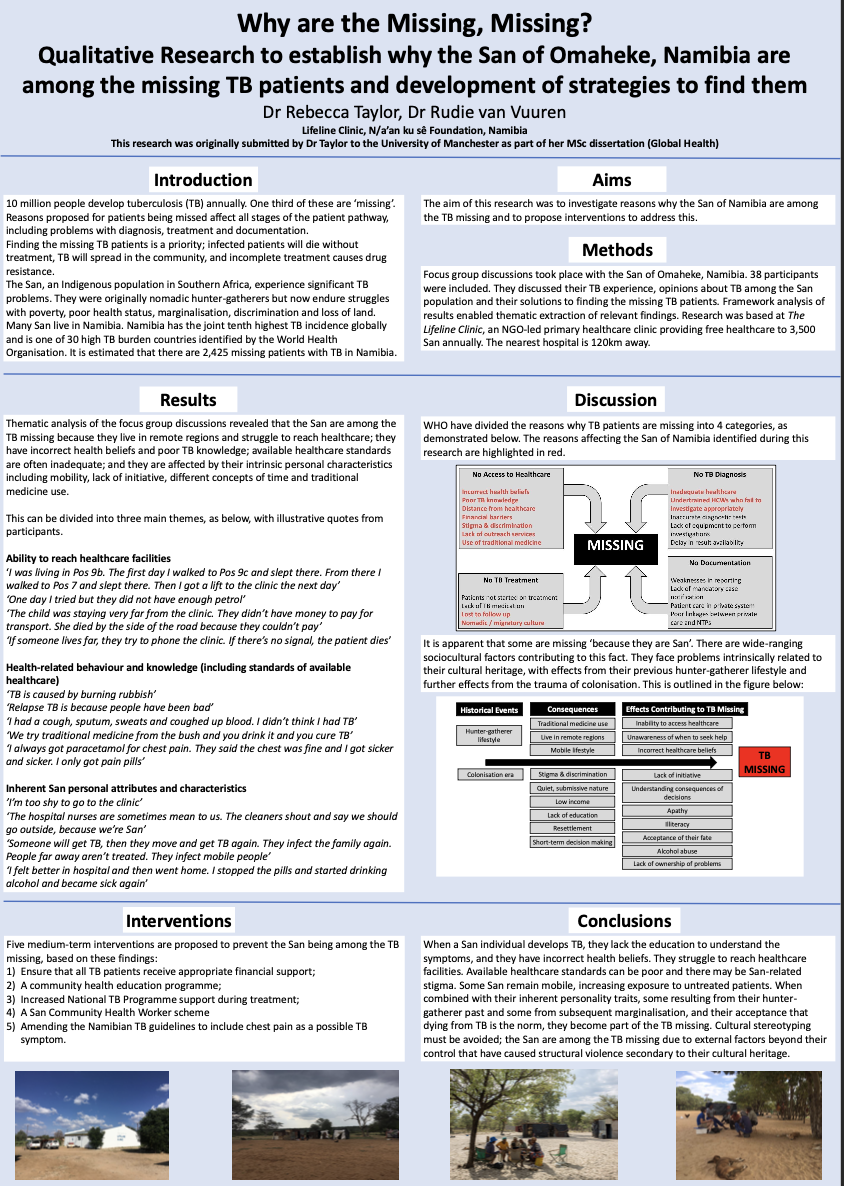
WEM25 – Poster Competition Winners
Highly Commended
Into Thin Air(ways): A Scoping Review of the Effects of High Altitude on Anaesthetic Administration in Pre-Hospital Environments | Olivia Hobrough et al.
A scoping review evaluating 21 studies on how high altitude (HA) affects anaesthetic delivery in pre-hospital settings. Findings show that hypobaric hypoxia alters pharmacodynamics and equipment function, increasing risk during general anaesthesia. Ketamine and methoxyflurane were identified as safer agents, while inhalational anaesthetics and nitrous oxide were unreliable. Evidence for regional and local anaesthesia remains limited, and no altitude-specific clinical guidelines currently exist. The study calls for multicentre collaboration and standardised research to inform safer pre-hospital anaesthetic practice at altitude.
Exploring the Impact of Space Radiation on the Kidney: Houston, We May Have a Carcinogenesis Problem | Harry Hughes – Digital Submission Only
A molecular study analysing kidney tissue from the International Space Station and ground-based radiation simulations to investigate the effects of galactic cosmic radiation (GCR). Results revealed activation of renal cancer pathways, DNA damage hotspots, and co-localisation of γH2AX and phospho-SPAK markers, indicating a focal repair response. Findings suggest the kidney is vulnerable to space radiation–induced carcinogenesis, supporting its inclusion in NASA’s organ-specific risk frameworks for long-duration missions.
Condom Balloon Tamponade: From Birth Control to Postpartum Haemorrhage Control | Shahin Saif – Digital Submission Only
Using Ultrasound to Diagnose and Monitor High Altitude Pulmonary Oedema: A Scoping Review | Sophie Shergold
A scoping review assessing ultrasound (USS) as a diagnostic and monitoring tool for high-altitude pulmonary oedema (HAPE). Across five studies, ultrasound detected increased B-lines—markers of extravascular lung water—in HAPE patients compared to controls, with improvements after treatment or descent. USS showed high sensitivity (0.98) and specificity (0.91), demonstrating strong potential for field diagnosis in expedition and pre-hospital settings. Further research is needed to evaluate its use with portable devices and in early or sub-clinical HAPE detection.
Aviation Medical First Responder Simulation Training for Unexpected Responders: High-Fidelity Simulation for In-Flight Emergencies | Daniel Olaiya
A study evaluating the impact of high-fidelity simulation in preparing healthcare professionals and remote medics for in-flight emergencies. Conducted onboard a decommissioned Boeing 737, the Aviation Medical First Responder (AvMFR) course covered aviation physiology, prolonged field care, and emergency management. Participant confidence scores rose from 2.0–2.8 pre-course to 4.3–4.6 post-course, with strong feedback on realism and teamwork. Results highlight the feasibility and educational value of aviation-based simulation for clinical preparedness in confined and austere environments.
Gut Check at the Extremes: Microbiome in Space and Expeditionary Medicine and the Role of Probiotics | Kindalem Fentie et al.
A literature review examining how extreme environments—spaceflight, polar expeditions, high altitude, and submarine missions—disrupt the human microbiome. Findings across these settings reveal decreased microbial diversity, increased opportunistic pathogens, and reduced immune stability. Probiotics show promise in mitigating these effects, improving gastrointestinal comfort and immune balance. The study calls for environment-specific probiotic strategies and highlights microbiome protection as a central component of resilience and mission success in space and expeditionary medicine.
Other Submissions
“I’m a Casualty, Get Me Out of Here”: Extrication Equipment and Training in UK Mountain Rescue Teams | Anton Beka et al.
A national survey of 21 UK mountain rescue teams revealed both common practices and significant variation in extrication techniques. While all teams used vacuum mattresses and rope systems, only 48% used cervical collars despite contested evidence. Training frequency ranged from monthly to biannual, and analgesia was universally available but with differing formularies. Findings highlight the need for consensus-building, standardised training, and further research to optimise pre-hospital extrication in austere environments.
DKA Management in Resource-Limited Settings | Shahin Saif – Digital Submission Only
A case report from a rural Zambian clinic describing pragmatic management of diabetic ketoacidosis without access to advanced monitoring tools. Using IV fluids, gravity-drip insulin, and ECG-guided potassium supplementation, the approach highlights safe, physiology-based strategies relevant to rural and remote healthcare worldwide.
Counteracting Microgravity-Induced Bone Loss in Astronauts | Harvey White
A systematic review of bisphosphonates as a countermeasure to bone loss in space. Current evidence shows astronauts lose 0.4–1.6% bone mineral density per month in microgravity, even with exercise devices. Studies of alendronate and zoledronate in astronauts and animal models suggest bisphosphonates can significantly reduce or even reverse bone density loss. While side effects are manageable, larger astronaut studies are needed to confirm long-term safety and structural quality of chemically preserved bone
Does Intermittent Exposure to High Altitude Cause Persistent Cognitive Impairment in Mountaineers? A Scoping Review | Hannah Morris et al. – Digital Submission Only
Freediving as a Tool for PTSD Treatment and Enhanced Warfighter Performance | Cerise Cisneros
A review of 19 studies exploring the physiological and psychological effects of freediving. Findings show reduced heart rate, improved heart rate variability, higher nitric oxide levels, and preserved cognitive function under hypoxic stress. The study proposes freediving as both a therapeutic intervention for PTSD and a performance-enhancement method for military personnel, highlighting its cost-effectiveness and potential to support resilience, emotional regulation, and team performance.
The Slava Topol Project: Establishing a Preventative Search and Rescue Service on Peak Lenin | Yasmin Down
A field project addressing the absence of structured medical and rescue support on Peak Lenin (7,134m) along the Kyrgyzstan–Tajikistan border. In 2025, volunteer medics established medical posts at Base Camp (3,600m) and Advanced Base Camp (4,400m), conducting 124 consultations across eight weeks. Cases ranged from chronic disease and soft tissue injuries to AMS, HAPE, and HACE. Collaboration with local medics improved evacuation protocols and education outreach in local languages. The project aims to develop a sustainable mountain rescue framework integrated into existing local systems.
Don’t Be Scared of Fake Blood! How Simple Moulage Can Add Fidelity and Enhance Learning in Student-Led Wilderness Simulation | Bea Rae et al.
A Dundee University Wilderness & Expedition Medicine Society (WEMS) project demonstrating how low-cost moulage materials can enhance realism and learning outcomes in wilderness simulation training. Using simple tools such as catheter bags, food dye, and tape, students created high-fidelity injury simulations. Feedback showed 100% of participants found moulage-based teaching improved confidence, stress management, and skill retention—supporting its wider use in undergraduate medical education.
Where Plans Fly or Fall: A Mass Casualty Simulation Implementation and Lessons Learned | Thomaz de Carvalho Lima Paiva et al.
An experience report from Afya-UNIMA and CESMAC University in Brazil detailing the design and delivery of a simulated explosion at a medical school graduation. The exercise involved 34 casualties and ten student rescue crews using the START triage system. The simulation provided a realistic, high-stress environment where students practised emergency procedures under pressure, enhancing decision-making and teamwork. Organisers reported significant educational value for both participants and planners, reinforcing the importance of large-scale simulation in medical education.
Treat the Syndrome, Not the Snake: Envenoming in Rural Nepal — A Case Report | Sam Horton et al.
A case report from eastern Nepal describing the management of a 59-year-old woman bitten by a suspected pit viper while cutting grass. Despite local swelling, coagulation tests remained normal, and 10 vials of polyvalent antivenom were administered without adverse reaction. The case supports the WHO-endorsed syndromic approach to snakebite management—treating clinical presentations rather than species identification. Recommendations include early transfer, use of point-of-care coagulation testing, and prophylactic adrenaline to prevent antivenom anaphylaxis.
Women’s Health in Space Health Research: Where Are the Data? | Mariam Adenike Kareem – Digital Submission Only
A scoping review analysing 85 papers published between 1989 and 2025 to evaluate progress and gaps in women’s health research in space. The review found a post-2014 surge in female-focused studies, though most data still rely on retrospective or ground-based analogues. Reproductive and cardiovascular domains are best studied, while immune and neurovestibular systems remain under-researched. The findings emphasise the need for female-specific countermeasures, long-term health monitoring, and sex-based mission planning to ensure astronaut safety on future Moon and Mars missions.
When the Wild Bites Back: Managing Snake, Crocodile and Hippo Injuries in a Rural Zambian Hospital | Jonathan McAdam et al.
A retrospective six-year review of wildlife-related injuries at a rural hospital in north-western Zambia. The study analysed cases of snakebites, crocodile attacks, and hippo-related trauma requiring surgical intervention. Snakebites were most common, often leading to necrosis and infection but no fatalities. Crocodile attacks caused severe lacerations and fractures, while one hippo incident resulted in a dislocation requiring reduction. Findings underscore the need for improved trauma preparedness, antivenom access, and public education in high-risk riverine communities.
Improvisation Under Pressure: Managing Airway Foreign Bodies Without Specialist Equipment | Jonathan McAdam et al.
A retrospective case series from Chitokoloki Mission Hospital, Zambia, reviewing ten paediatric cases of airway foreign body aspiration between 2017 and 2025. With limited access to bronchoscopy or paediatric airway instruments, clinicians improvised by combining tracheostomy with adapted tools such as a rigid cystoscope and Fogarty catheter for safe removal. All procedures were successful with no recorded mortality. The study highlights practical innovation in resource-limited environments and emphasises calm preparation, adaptability, and multidisciplinary teamwork in airway emergencies.



